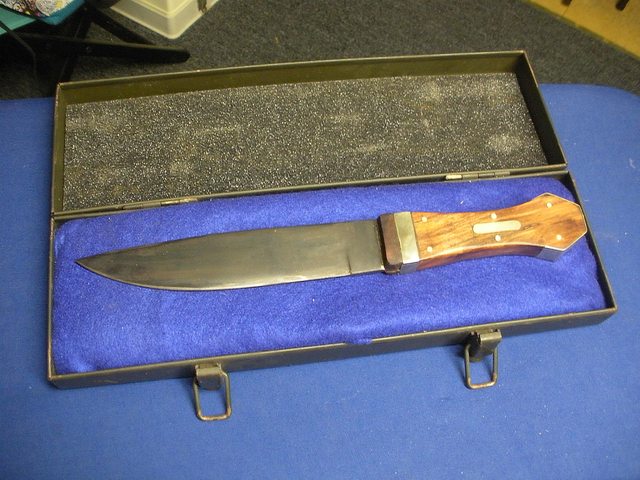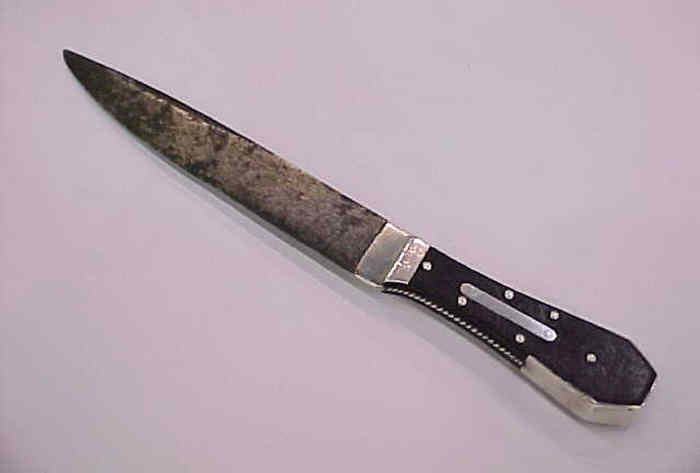The topic of Hudson's Bay Camp knives came up in the Classified section, and rather than divert attention from the forum member's ad, we can move the discussion over here.
Just to be clear, we are talking about knives like this one:

I don't remember how I first heard about these, but it was some time in the early seventies. Maybe from Carl Russell's book, Firearms, Traps, and Tools of the Mountain Men. There was an illustration of an HBC camp knife in that book, and a long paragraph of text discussing it. Not long after, I met a fellow who owned one, and he was kind enough to trace it and fill in the tracing with a very detailed drawing of the knife. I wanted one of my own after that. I narrowly missed getting an original at a very good price a few years ago, and as a consolation, I bought one from Dean Hazuka of Montana Americana. Dean makes a very good reproduction. This is the picture he took of my knife before he mailed it to me:

This is a big knife. She weighs 20 ounces without her nightgown, and the blade is 8-3/4" long by two inches wide at the choil. The blade is .232" thick, or just under a quarter of an inch. The handle is five inches long. The walnut scales are pinned on with iron pins through very large (3/4") sheet brass washers. The originals, when new, were typically hafted with water buffalo horn, imported from Asia to the cutlers of England. You occasionally see these with other materials for handles, like this one in the McCord Museum:

This one reportedly has a "bone" handle. I suspect the original handle split or came off somehow, and was replaced in the field. You sometimes hear that these knives, as well as butcher knives, were sold as blade "blanks," to be hafted by the end users, but I haven't found anything in the primary source material to corroborate this. In my opinion, the "country made" handles were replacements.
The best information I have indicates these were first introduced by the HBC sometime in the mid-19th century. This was from a short article in Canada's History magazine (December 2012 - January 2013 issue), Spectacular Knife. Also, in an article entitled "Collection Corner - The Buffalo Knife," apparently by Charles Hanson, in the Museum of the Fur Trade Quarterly (Vol. 13, No. 3, Fall 1977), the author said, "During the last half of the nineteenth century a very spectacular knife was popular with the buffalo hunters on the western plains of Canada." If you are a hard-core reenactor, dates like this are important. The point being that you probably would not have seen one of these at a pre-1840 rendezvous. However, just today I found a listing online for a knife that may have been a direct ancestor of the camp knife. This one is dated 1834. It differs from the camp knife in some particulars, but you can see some similarities, too:

In any event, these knives were very popular with the native and Metis hunters. In Saskatchewan and the Rocky Mountains (published in 1875), author James Carnegie wrote:

In The Great Fur Land, published in 1879, Henry Robinson wrote:

So, these knives were used for skinning and butchering animals large and small, and for cutting wood. John Ewers wrote that Blackfoot raiders carried "heavy knives," and these were used in construction of war lodges, which were A-framed structures of logs and poles used to provide shelter for men out on the trail. In the book, Piegan, by Richard Lancaster, it was recorded that large knives were used for digging "foxholes," or rifle pits. In his book, On Snowshoes to the Barren Grounds, Caspar Whitney reported his Dogrib companions carried similar knives:


I have not really found any indication that the Anglo hunters or trappers used these much. You see frequent references in the literature to "butcher knives" and "scalping knives," but it appears from the reading I have done that the white fellows preferred hatchets for chopping. Dick Wooton said, "In a belt, which he [the typical trapper] always wore, he carried a couple of pistols, two large knives and a tomahawk. What we called a tomahawk was a kind of hatchet which we used to chop our meat up with, and in fact to do all the chopping that we had to do" ("Uncle Dick" Wootton, p.55). In My Sixty Years on the Plains, Bill Hamilton said, "Each man had his tooth-pick or large knife in his belt, besides a trapping hatchet. The latter contained two pounds of steel, a sharp and dangerous weapon in the hands of determined men who were contending for their lives" (p. 151).
So, what we have here is a very useful, multi-purpose wilderness tool that came into being sometime in the mid-1800's. This was a unique type of cutlery, specifically developed for the fur trade, and used for skinning everything from ground squirrels to buffalo. I think of it as primarily a Canadian knife, but we know for sure a few of them were carried south of the Medicine Line on the belts and in the hands of native and Metis hunters. The people who used these knives seemed to appreciate them, and more than one 20th century writer called them "spectacular."
Best regards,
Notchy Bob
Just to be clear, we are talking about knives like this one:

I don't remember how I first heard about these, but it was some time in the early seventies. Maybe from Carl Russell's book, Firearms, Traps, and Tools of the Mountain Men. There was an illustration of an HBC camp knife in that book, and a long paragraph of text discussing it. Not long after, I met a fellow who owned one, and he was kind enough to trace it and fill in the tracing with a very detailed drawing of the knife. I wanted one of my own after that. I narrowly missed getting an original at a very good price a few years ago, and as a consolation, I bought one from Dean Hazuka of Montana Americana. Dean makes a very good reproduction. This is the picture he took of my knife before he mailed it to me:

This is a big knife. She weighs 20 ounces without her nightgown, and the blade is 8-3/4" long by two inches wide at the choil. The blade is .232" thick, or just under a quarter of an inch. The handle is five inches long. The walnut scales are pinned on with iron pins through very large (3/4") sheet brass washers. The originals, when new, were typically hafted with water buffalo horn, imported from Asia to the cutlers of England. You occasionally see these with other materials for handles, like this one in the McCord Museum:

This one reportedly has a "bone" handle. I suspect the original handle split or came off somehow, and was replaced in the field. You sometimes hear that these knives, as well as butcher knives, were sold as blade "blanks," to be hafted by the end users, but I haven't found anything in the primary source material to corroborate this. In my opinion, the "country made" handles were replacements.
The best information I have indicates these were first introduced by the HBC sometime in the mid-19th century. This was from a short article in Canada's History magazine (December 2012 - January 2013 issue), Spectacular Knife. Also, in an article entitled "Collection Corner - The Buffalo Knife," apparently by Charles Hanson, in the Museum of the Fur Trade Quarterly (Vol. 13, No. 3, Fall 1977), the author said, "During the last half of the nineteenth century a very spectacular knife was popular with the buffalo hunters on the western plains of Canada." If you are a hard-core reenactor, dates like this are important. The point being that you probably would not have seen one of these at a pre-1840 rendezvous. However, just today I found a listing online for a knife that may have been a direct ancestor of the camp knife. This one is dated 1834. It differs from the camp knife in some particulars, but you can see some similarities, too:

In any event, these knives were very popular with the native and Metis hunters. In Saskatchewan and the Rocky Mountains (published in 1875), author James Carnegie wrote:

In The Great Fur Land, published in 1879, Henry Robinson wrote:

So, these knives were used for skinning and butchering animals large and small, and for cutting wood. John Ewers wrote that Blackfoot raiders carried "heavy knives," and these were used in construction of war lodges, which were A-framed structures of logs and poles used to provide shelter for men out on the trail. In the book, Piegan, by Richard Lancaster, it was recorded that large knives were used for digging "foxholes," or rifle pits. In his book, On Snowshoes to the Barren Grounds, Caspar Whitney reported his Dogrib companions carried similar knives:


I have not really found any indication that the Anglo hunters or trappers used these much. You see frequent references in the literature to "butcher knives" and "scalping knives," but it appears from the reading I have done that the white fellows preferred hatchets for chopping. Dick Wooton said, "In a belt, which he [the typical trapper] always wore, he carried a couple of pistols, two large knives and a tomahawk. What we called a tomahawk was a kind of hatchet which we used to chop our meat up with, and in fact to do all the chopping that we had to do" ("Uncle Dick" Wootton, p.55). In My Sixty Years on the Plains, Bill Hamilton said, "Each man had his tooth-pick or large knife in his belt, besides a trapping hatchet. The latter contained two pounds of steel, a sharp and dangerous weapon in the hands of determined men who were contending for their lives" (p. 151).
So, what we have here is a very useful, multi-purpose wilderness tool that came into being sometime in the mid-1800's. This was a unique type of cutlery, specifically developed for the fur trade, and used for skinning everything from ground squirrels to buffalo. I think of it as primarily a Canadian knife, but we know for sure a few of them were carried south of the Medicine Line on the belts and in the hands of native and Metis hunters. The people who used these knives seemed to appreciate them, and more than one 20th century writer called them "spectacular."
Best regards,
Notchy Bob
Last edited:






















